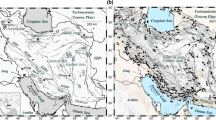Abstract
Vertical coseismic deformation on non-causative fault caused by remote strong earthquakes (epicentral distance ≥1 500 km, M S≥7.0) are observed by fault-monitoring instruments of new type during recent two years. The monitoring result shows, delay time, maximum amplitude and duration of vertical deformation on the non-causative fault have remarkable close relationship with earthquakes magnitude and epicentral distance. The delay time of vertical coseismic deformation have positive linear relationship with epicentral distance. The velocity of coseismic deformation is 5.5 km/s, close to the velocity of surface wave in granite. The logarithms of maximum amplitude of coseismic deformation and epicentral distance have remarkable linear relationship with magnitude. The greater the magnitude and the closer the epicentral distance are, the bigger the maximum amplitude of coseismic deformation on non-causative fault will be. Relative to the epicentral distance, the magnitude is the most important factor to the duration of coseismic vertical deformation on the non-causative fault. Stronger earthquake causes longer vibration duration of coseismic deformation. The experiential equation of co-seismic deformation faults obtained by this work is significant on the coseismic deformation research.
Similar content being viewed by others
References
DENG Qi-dong, FENG Xian-yue, ZHANG Pei-zhen, et al. 2000. Active Tectonics of the Chinese Tianshan Mountain [M]. Beijing: Seismological Press: 126–146 (in Chinese).
Guternberg B. 1945. Amplitudes of surface waves and magnitude of shallow earthquake [J]. BSSA, 35: 3–12.
JING Yan, ZHAO Ying-hai, ZHANG Hong-xu, et al. 2005. Monitoring of Dushanzi-Anjihai fault with single-baseline, two-component, obliquely-crossing-fault instrument [J]. Journal of Seismological Research, 28(2): 192–195 (in Chinese).
LI Xin and LI Ya. 1998. Shock absorption effect of Jinzhou fault [J]. Seismological Research of Northeast China, 14(2): 24–27 (in Chinese).
MA Xing-yuan. 1989. Lithospheric Dynamics Atlas of China [M]. Beijing: Sinomaps Press: 129–132 (in Chinese).
NIU An-fu, ZHANG Jing, JI Ping. 2005. Conseismic deformation response of strong earthquake [J]. Inland Earthquake, 19(1): 1–7 (in Chinese).
QIU Ze-hua and SHI Yao-lin. 2003. Observation of remote coseismic stress step-changes [J]. Science in China (Series D), 46(Suppl.): 75–81 (in Chinese).
WANG Jian-jun. 2004. Technique study of across-fault deformation measurement and its application [J]. Chinese Journal of Rock Mechanics and Engineering, 23(2): 261–266 (in Chinese).
ZHANG Chao and GUO Jia-yuan. 1987. Introduction to fault deformation monitoring using short base line and short leveling method [G]//Bulletin of the Institute of Crustal Dynamics (1). Beijing: Seismological Press: 54–69 (in Chinese).
Author information
Authors and Affiliations
Corresponding author
Additional information
Foundation item: Joint Seismological Science Foundation of China (605021)
About this article
Cite this article
Jing, Y., Zhang, Sz., Li, H. et al. Response of vertical deformation on faults to remote strong earthquakes. Acta Seimol. Sin. 20, 172–179 (2007). https://doi.org/10.1007/s11589-007-0172-2
Received:
Accepted:
Issue Date:
DOI: https://doi.org/10.1007/s11589-007-0172-2




